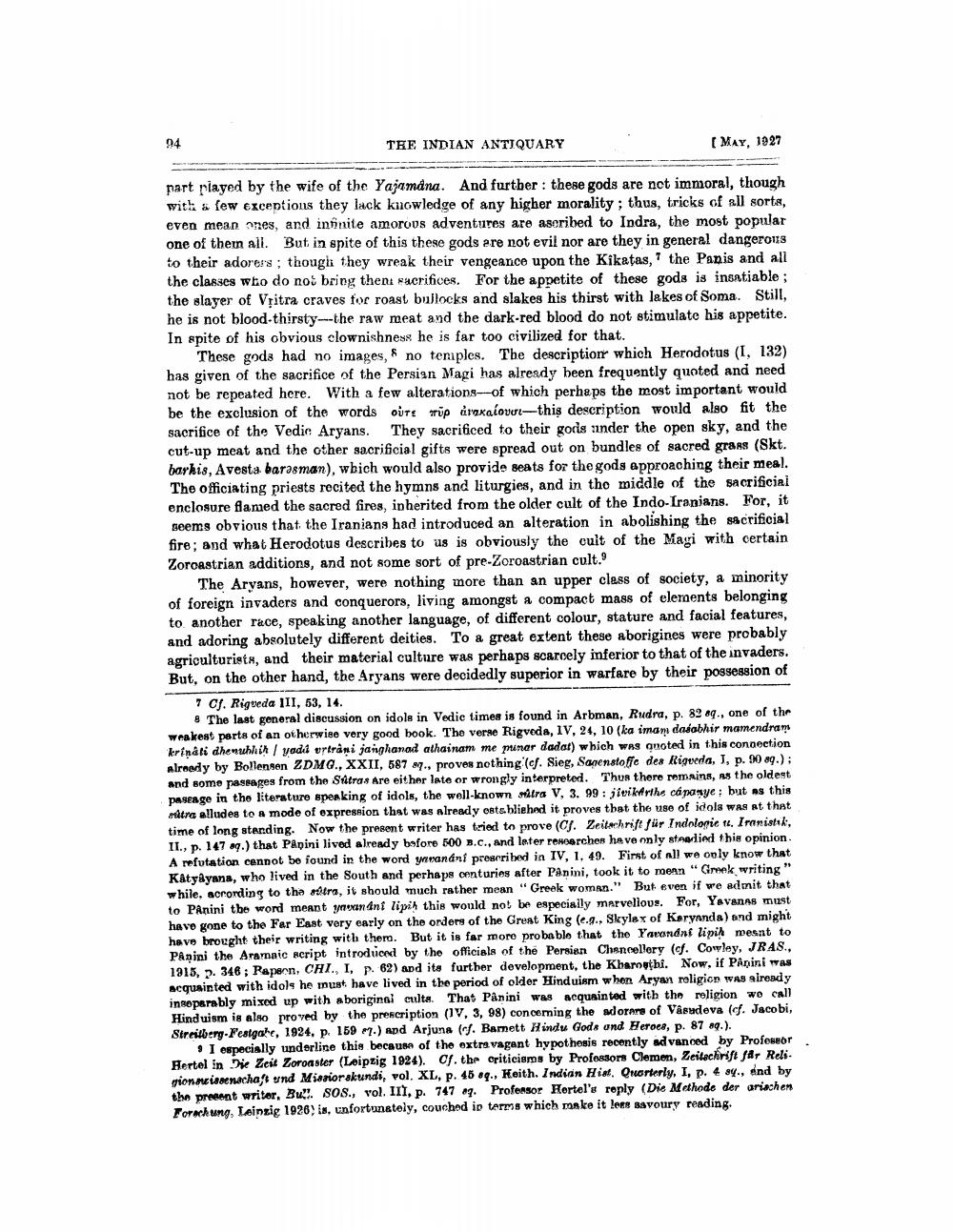________________
94
THE INDIAN ANTIQUARY
[MAY, 1927
part riayed by the wife of the Yajamdna. And further : these gods are not immoral, though with a few exceptions they lack kuowledge of any higher morality; thus, tricks of all sorts, even mean mes, and infinite amorous adventures are ascribed to Indra, the most popular one of them all. But in spite of this these gods are not evil nor are they in general dangerous to their adorer's; though they wreak their vengeance upon the Kikatas,' the Panis and all the classes who do nos bring then sacrifices. For the appetite of these gods is insatiable; the slayer of Vșitra craves for roast bullocks and slakes his thirst with lakes of Soma. Still, he is not blood-thirsty--the raw meat and the dark-red blood do not stimulate his appetite. In spite of his obvious clownishness he is far too civilized for that.
These gods had no images, $ no temples. The descriptiorr which Herodotus (I, 132) has given of the sacrifice of the Persian Magi has already been frequently quoted and need not be repeated here. With a few alterations-of which perhaps the most important would be the exclusion of the words Oute rüp áraxalovut--this description would also fit the sacrifice of the Vedic Aryans. They sacrificed to their gods under the open sky, and the cut-up meat and the other sacrificial gifts were spread out on bundles of sacred grans (Skt. barkis, Avesta barəsman), wbich would also provide seats for the gods approaching their meal. The officiating priests recited the hymns and liturgies, and in the middle of the sacrificiai enclosure flamed the sacred fires, inherited from the older cult of the Indo-Iranians. For, it seems obvious that the Iraniang had introduced an alteration in abolishing the sacrificial fire; and what Herodotus describes to us is obviously the cult of the Mayi with certain Zoroastrian additions, and not some sort of pre-Zoroastrian cult.
The Aryans, however, were nothing more than an upper class of society, a minority of foreign invaders and conquerors, living amongst a compact mass of eleraents belonging to another race, speaking another language, of different colour, stature and facial features, and adoring absolutely different deities. To a great extent these aborigines were probably agriculturists, and their material culture was perhaps scarcely inferior to that of the invaders. But, on the other hand, the Aryans were decidedly superior in warfare by their possession of
7 Cf. Rigveda III, 53, 14.
8 The last general discussion on idols in Vedic times is found in Arbman, Rudra, p. 82 8q., one of the weakest parts of an otherwise very good book. The verse Rigveda, IV, 24, 10 (ka iman dasabhir mamendram krinati dhenuhhin / yadii ertrani janghanad athainam me panar dadat) which was anoted in this consection already by Bollensen ZDMG., XXII, 587 9., proves nothing (cf. Sieg, Sanenstofie des Rigveda, J, p. 90 09.); and some passages from the Satras Are either late or wrongly interpreted. Thus there romains, as the oldest paseage in the literature speaking of idols, the well-known stra V, 3. 99 : jei krths cápanye, but as this mitra alludes to a mode of expression that was already established it proves that the use of idols was at that time of long standing. Now the present writer has tried to prove (Cf. Zeitschrift für Indologic ft. Iranistik, II, p. 147 aq.) that Papini lived already before 500 B.C., and later researches have only stralind this opinion. A futation cannot be found in the word ywananí prescribed in IV, 1, 40. First of all we only know that Katyayana, who lived in the South and perhaps centuries after Panini, took it to mean "Greek writing" while, acrording to the stre, it should much rather mean "Greek woman." But even if we admit that to Panini tbe word meant nuandni lipin this would not be especially marvellous. For, Yavanas must have gone to the Far East very early on the orders of the Great King (e.g., Skyles of Korynnda) and might have brought their writing with them. But it is far more probable that the Yarandni lipi mesnt to Panini the Araynnie script introduced by the officials of the Persian Chancellory (of. Cowley, JRAS, 1915, 9. 346 ; Papern, CHI, I, p. 62) and its further development, the Khamoshi. Now, if Panini was acquainted with idols he must have lived in the period of older Hinduism when Aryan religion was already inseparably mixed up with aboriginal culta. That Panini was acquainted with the religion we call Hinduism is also proved by the prescription (IV, 3, 98) con coming the more of Vasudeva (cf. Jacobi, Streitberg-Festgahe, 1924, p. 159 7.) and Arjuna (cf. Bamett Hindu Gods und Heroes, p. 87 9.).
I especially underline this because of the extravagant hypothesis recently advanced by Profesor Hertel in The Zeit Zoroaster (Leipzig 1924). Cf. the criticisms by Professors Clemen, Zeitschrift får Relipionncissenschaft und Misriorakundi, vol. XL, p. 45 oq., Heith. Indian Hial. Quorterly, I, p. 4 ay.. and by the present writer, Bu". SOS., vol. III, p. 747 9. Professor Hortel's reply (Die Methode der arischen Forschung Lainzig 1926) is, unfortunately, couched in terms which make it lees savoury reading.




